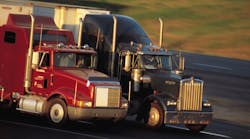Truckers know all about regulations. From hours of service to CSA, it seems that a truck can’t drive more than a mile without running into a regulation of some type. Some regulations, though, keep changing. Targets move. The industry reacts, and then the target moves again.
That seems to be the case with greenhouse gas emissions and truck fuel efficiency regulations. And even with the 2010 EPA emissions regulations that cut particulate matter to 0.01 grams per horsepower-hour and NOx to 0.2, resulting in what some claim is cleaner diesel exhaust than the air we breathe in some counties, the government wasn’t done.
Just when the industry had wrapped its collective head—and equipment—around EPA 2010, the agency, along with the National Highway Traffic Safety Administration (NHTSA), proposed new greenhouse gas emissions and fuel-efficiency standards for medium- and heavy-duty trucks. That regulation, the first phase of which is now being implemented by every major truck manufacturer, changed the equation. When fully implemented, it is expected to cut fuel consumption per vehicle by as much as 23%, says the National Resources Defense Council (NRDC).
The purpose of the Phase I 2014-2018 model-year standards, much like the Phase II regulations that will be unveiled sometime early next year, is to focus attention away from “local emissions” toward “global emissions.”
“For a long time, the focus of the efforts in trucking has been on particulate matter,” says Jason Mathers, senior manager at the Environmental Defense Fund. “[That] is what the environmental industry has been focused on for the past 20 years, through 2004, 2007 and 2010. Where we find ourselves now is, in many respects, a pivot [with a focus on carbon dioxide]. It requires different types of regulations.”
Earlier this year, the Obama Administration announced the president’s Climate Action Plan, which includes developing “post-2018 fuel economy standards for heavy-duty vehicles to further reduce fuel consumption through the application of advanced cost-effective technologies,” a.k.a. the Phase II regulations.
Few details are available, although there are plenty of guesses as to what those new rules will require in terms of technologies to meet the standards.
Christopher Grundler, EPA’s director of the Office of Transportation and Air Quality, told a panel at the Alternative Clean Transportation Expo in May that the policy was in its “very early days” and “[EPA has] begun some technical work in this area, but scope and schedule are all to be determined.” He said that areas now under consideration “span the gamut from better engines, to better transmissions, to better aerodynamic designs, to fuel-based strategies.”
Like the first phase of regulations, collaboration between the industry, environmental groups, and government agencies is expected to make crafting the regulations a truly winning proposition for all.
REGULATORY NEED
With more and more fleets adopting technologies designed to make vehicles more efficient and cut fuel usage, the question remains as to whether the industry really needs the government involved. As it turns out, though, there is good reason for its involvement.
“The role for these standards is to set certain levels for manufacturers to generate innovation,” points out Mathers. “We need these rules and we need more rules to give certainty that, eight years from now, there will be a market for more fuel-efficient engines. It says to manufacturers that if you develop a product that saves fuel, there will be a market for it.”
That is an opinion also expressed by Luke Tonachel, director-vehicles and fuels project, for the NRDC.
“With the uncertainty of the demand from new-truck buyers for new technologies, the regulations provide manufacturers certainty that their investment in technology will not be wasted,” he says, adding that it also levels the playing field for manufacturers. Manufacturers, and fleets for that matter, are assured that the technology they invest in will provide the fuel savings and payback that it promises—a promise that cannot be assured if there are no minimum standards to meet, Tonachel says.
So with the regulations focused as much on creating market certainty as on reducing fuel, fleet focus turns quickly to cost. Regardless of the fuel savings possible, if the upfront cost—and there will be upfront cost—is too high, a fleet may not invest, a point acknowledged by Tonachel.
He notes that the stated goal in developing the rules specifies that the technologies needed to achieve the standards must provide “maximum feasible viability” and also be “cost-effective.” With fuel savings potential of up to $30,000 per year for a tractor-trailer, Tonachel says fleets will experience savings, even with higher price tags for equipment. He also mentions that NRDC is hoping that mpg for tractors will eventually increase from a fleet-wide average of 6 mpg today to 11 mpg.
Jim Sweeney, vice president of capital equipment for AmeriQuest Transportation Services, noted in a recent blog entry that fleets will definitely see savings once the Phase II rules are put in place.
“The 2014-2018 standards should result in significant savings and benefits over the lifetime of the vehicles and as a whole could save owners and operators an estimated $50 billion in fuel costs,” he wrote. “There is no reason to doubt similar benefits will not be generated by the 2019 rules.”
Sweeney noted development of enhanced engine electronics, more efficient driveline components to reduce friction, idle reduction technologies, low-rolling resistance tires, and overall weight reduction of trucks and trailers as potential outcomes from the standards.
“The next round of standards will lower the cost of owning a truck,” says Mathers. “It will increase the cost of [buying] a truck, but the fuel savings will [result in a net savings].”
Like NRDC, EDF also has projected savings for trucks. If the Phase II regulations call for a 40% improvement in fuel efficiency over 2010, EDF calculates that fleets could save between $21,000 and $36,000 in fuel in the first year alone. That is a target that both Mathers and Tonachel believe is realistic and would be approximately double the Phase I standards (the actual standards vary based on vehicle type and application). They are “doable, achievable standards,” Mathers says.
In the end, Mathers says, the fact that industry, environmental groups, and government will work together to craft the rules is a positive and will lead to more achievable standards.
“I think it’s critical to have the voices of manufacturers,” he says, “but I think it’s just as important to have the [end users] like those that buy or sell trucks involved because they play a critical role in reducing costs and saving fuel.”
“EPA and NHTSA have a history of creating rules [that work], and I think that will be the case again,” Tonachel adds.
In some cases, that will be made easier, because the agencies will be able to tap the knowledge of California, which has had its own set of greenhouse gas trailer regulations for several years. EPA and NHTSA are both working with the California Air Resources Board (CARB) on developing the Phase II regulations, says Stephan Lemieux, manager of the on-road heavy-duty diesel section for CARB.
One of the lessons CARB learned, Lemieux notes, is that truckers are wary of new technologies.
“I think a lot of the times when it comes to aerodynamics and technology, there is a lot of skepticism out there because there are a lot of variables in running a truck,” he says. Because of that, CARB made the decision to weigh research data more heavily than real-world examples.
“When we looked at aerodynamics on trailers, we really looked at the scientific data because if we looked at fleets, some were reporting 3% improvement [with skirts] and others 7%,” he notes.
As a result, CARB turned to SAE fuel economy methodology and the EPA’s SmartWay Transport Partnership, which Lemieux says has done a good job of quantifying the improvements technologies can provide. In the end, he says the final decisions came down to creating an even playing field for all involved.
“What we’ve launched in California has started the thinking on incorporating trailers,” he says. “What’s been good about having the [California] rule in place for Phase II is that we have a lot of [experience] with technologies—and I think that will be good for the industry.”



